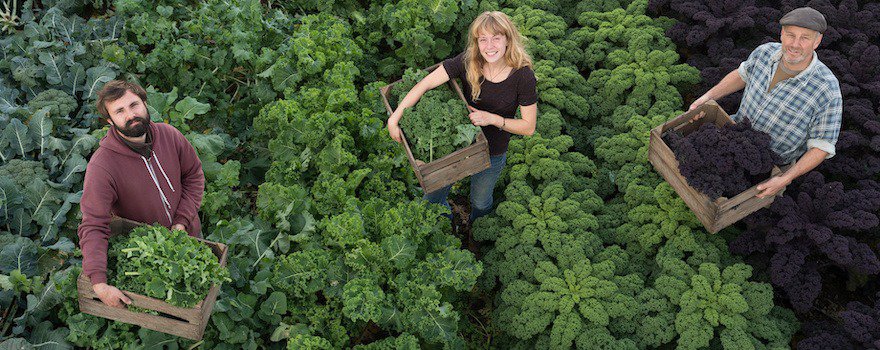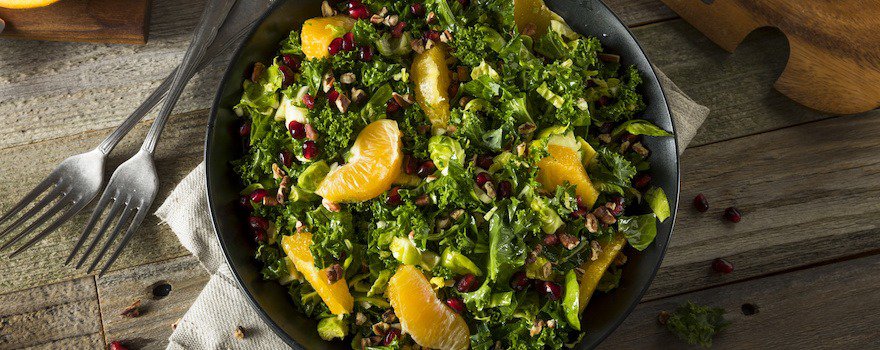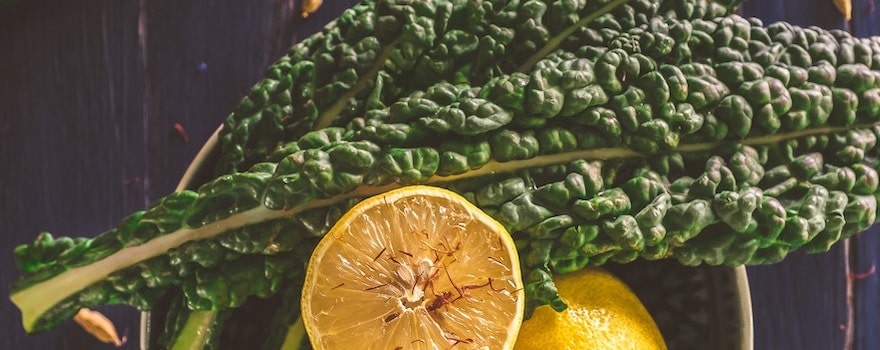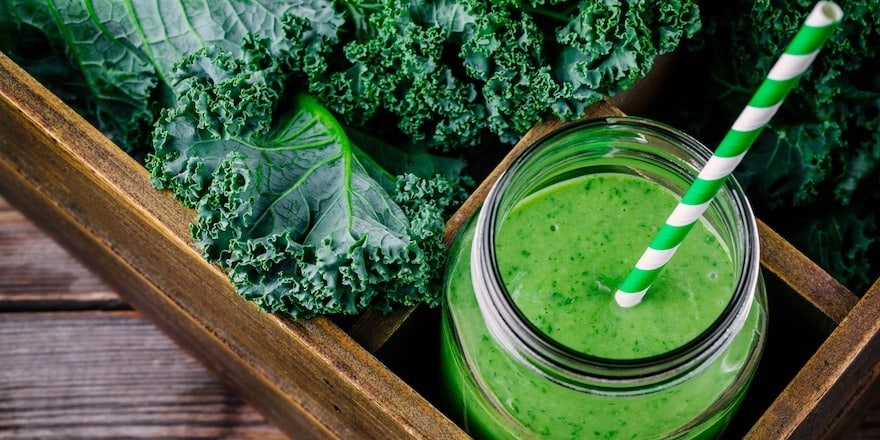BENEFITS OF KALE
✓ Antioxidant and protects against aging
✓ Protects the heart
✓ Protects the eyes
✓ May protect against cancer
✓ A wealth of vitamins C and K
What is kale?
Kale (also called leaf kale) (Brassica oleracea) refers to old varieties of non-heading, curly cabbages, black, purple or other types. It grows in bunches rather than in a head, so its leaves are harvested one by one. It is very cold-hardy, and its botanical profile brings it close to wild cabbages.
Its name may seem like a new food because it has gained increasing popularity in recent years, yet its cultivation in Asia Minor dates back to 2000 BC. Later, it was also part of the diet in ancient Greece and Rome.

During World War II, kale cultivation was encouraged in Great Britain by the Dig for Victory campaign, given how easily it grows and the large amount of nutrients it contains. It gradually disappeared from our diet, before returning to the public eye in the early 2000s.
Highly praised in the United States for its protective benefits, notably by celebrities very active in the healthy food scene such as Gwyneth Paltrow, it is gradually reappearing on our shelves. It is cooked in all sorts of ways, in salads, in soups, as chips… Raw or cooked, it also complements smoothies.
Why so much enthusiasm for this old cabbage? First, it has little taste compared with its flowering or Brussels cousins, which makes it easier to eat. Low in calories, it is high in proteins, minerals and vitamins — especially C and K, and very powerful antioxidants.

It’s being studied in particular for its ability to protect our eyes and fight age-related macular degeneration. Like other members of the Brassicaceae family, which also includes maca, it is thought to have anti-carcinogenic properties.
The small amount of fat it contains is mainly composed of omega-3s, including alpha-linolenic acid, an essential fatty acid. Kale is an ally for people wishing to lose weight or maintain a healthy weight because it is extremely nutritious while having a low caloric density.
Nutritional composition
- Proteins
- Vitamins A, K, C, B6, B9, E
- Minerals and trace elements: iron, calcium, potassium, manganese, phosphorus
- Antioxidants: beta-carotene, lutein, zeaxanthin, glucosinolates, polyphenols…

Kale benefits
★ Antioxidant and protects against aging
Kale protects against aging because it is particularly rich in antioxidants. It contains, for example, beta-carotene, a pigment that colors many vegetables, and that has powerful antioxidant activity.
It is also rich in vitamin C and various polyphenols, equally effective at fighting free radicals that damage our cells and are the primary factor in aging.
Its bioactive components also include two very interesting flavonoids, quercetin and kaempferol, which strengthen our blood vessels. They are also considered antiviral and antidepressant. Kale contains a lot of them!
This study by the Nofima Institute for Nutrition Research in Norway demonstrated the high levels of quercetin and kaempferol in kale.
★ Protects the heart
Kale helps lower cholesterol levels and protects us from heart disease.
Among its components are bile acid chelators, substances that help lower cholesterol levels in the body. This helps reduce the risk of heart problems.
This study by Yonsei University in Seoul showed that daily consumption of kale juice for three months increases levels of good cholesterol and lowers bad cholesterol in the body, while boosting the body’s antioxidant activity.
★ Protects the eyes
Kale protects the eyes and helps fight age-related macular degeneration. This disease, which causes a loss of central vision, is the leading cause of blindness in France among people over 50.
Kale’s high content of lutein and zeaxanthin, two antioxidant carotenoid pigments, helps prevent this disease and keep our eyes healthy.
This study by INSERM at Bordeaux II University showed that consumption of lutein and zeaxanthin reduces the risk of macular degeneration and cataracts.
★ May protect against cancer
Kale contains components that help fight cancer. But more in-depth studies still need to be conducted.
Among these is the sulforaphane. It is an organosulfur compound found in the Brassicaceae, the family of plants commonly called crucifers (cabbages, mustard, turnip…). This substance helps prevent cancer development at the molecular level.
It also contains indole-3-carbinol, which acts directly against the formation of blood vessels that feed tumors. This substance also has a protective action against radioactivity.
This study by Oregon State University in the United States demonstrated the mechanisms of action of cruciferous vegetables in fighting cancer and preventing it.
★ A wealth of vitamins C and K
Kale is an excellent source of vitamin C. It contains more vitamin C than oranges and most other fruits and vegetables. Vitamin C, beyond its antioxidant activity, strengthens the immune system, skin, and hair… It also helps synthesize collagen, which structures our tissues.
It is also very high in vitamin K, a vitamin essential for blood clotting and for binding calcium to the bones. It is one of the main sources: a large raw kale leaf contains 7 times more vitamin K than the recommended daily intake.

How to cook kale?
Where to find kale?
Kale was almost impossible to find in France a few years ago. A New Yorker, surprised not to find this super cabbage in Paris, worked from 2012 to reintroduce it to the country, by creating the Kale Project. Today, it is grown in many places, notably in Brittany, in the Gers, in Île-de-France and in Picardy.
You can find kale in organic supermarkets, at some markets, sometimes in large supermarkets, or via La Ruche qui dit Oui. This handy map lists the places where you can find it!
Kale salad

It’s the best way to enjoy all the benefits of kale! Raw, in a salad. You can also sauté it lightly. Just wash the leaves well, remove the thick stems and finely chop them. Garnish with cranberries or pomegranate seeds, nuts, feta, oranges, and season with lemon.
Kale chips

An entertaining alternative if you don’t like raw kale. Simply remove the stems and cut the leaves from the cabbage, place them on a baking sheet with oil and salt, then bake for 20 minutes.
Kale soup

A winter favorite or when your energy is low. It’s prepared with potatoes, carrots, broccoli, cream and lots of spices such as the turmeric and the ginger.
You can also make guacamole, pesto, boosting the nutrients in green smoothies…
Dosage
No specific dosage for kale; it can be consumed regularly in non-excessive amounts!
Contraindications and side effects
Overconsumption of kale can cause digestive issues.



